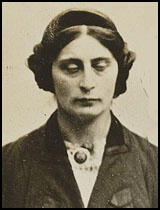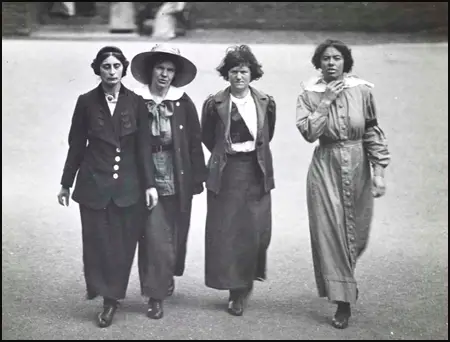Margaret Schenke

Margaret Schenke was born in Zwickau, Germany in 1888. She was the only child of her father's second marriage, but she had several half-brothers and sisters from her father's previous marriage.
Conflict with her parents resulted in her moving to England in about 1908. Soon afterwards she joined the Women's Social and Political Union (WSPU) and took part in several demonstrations.
Margaret sold copies of The Suffragette at Hyde Park Corner. She later recalled that men would come up to her and made the "most beastly sexual remarks". On another occasion "a lot of hooligans came on the scene, took my flag and tried to get hold of me. It was most terrifying but then suddenly I found myself held by two policemen and two on horseback got rid of the crowds, all four led me out of the park and put me on the bus." (1)
In January 1913, Emmeline Pankhurst made a speech where she stated that it was now clear that Herbert Asquith had no intention to introduce legislation that would give women the vote. She now declared war on the government and took full responsibility for all acts of militancy. "Over the next eighteen months, the WSPU was increasingly driven underground as it engaged in destruction of property, including setting fire to pillar boxes, raising false fire alarms, arson and bombing, attacking art treasures, large-scale window smashing campaigns, the cutting of telegraph and telephone wires, and damaging golf courses". (2)
On 24th February 1913, Emmeline Pankhurst was arrested for procuring and inciting persons to commit offences contrary to the Malicious Injuries to Property Act 1861. The Times reported: "Mrs Pankhurst, who conducted her own defence, was found guilty, with a strong recommendation to mercy, and Mr Justice Lush sentenced her to three years' penal servitude. She had previously declared her intention to resist strenuously the prison treatment until she was released. A scene of uproar followed the passing of the sentence." (3)
Schenke decided to protest against the imprisonment of Emmeline Pankhurst: "When Mrs Pankhurst was arrested there was a protest march of suffragettes which I joined and I decided then to make my personal protest by throwing a stone through a Home Office window. I discussed this with two women (sisters), I walked with but did not know. They were most helpful, took me to their home and let me telephone home to say I might not be back. They gave me a stone. Then one of them also made a telephone call. Later it emerged that that they were spies and had warned Scotland Yard. So a detective waited kindly for me. For personal reasons I could not go to prison in my own name, so I became Margaret Scott and I got a one month sentence." (4)
Margaret Schenke was sentenced to one month and sent to Holloway Prison. Soon after her arrival surveillance photographs of Margaret were taken from a van parked in the prison exercise yard. The images were compiled into photographic lists of key suspects, used to try and identify and arrest Suffragettes before they could commit militant acts. (5)

exercising in the yard of Holloway prison (February 1913)
Schenke married Richard Dixon in July 1914. On the outbreak of the First World War the WSPU carried out secret negotiations with the government and on the 10th August the government announced it was releasing all suffragettes from prison. In return, the WSPU agreed to end their militant activities and help the war effort. Christabel Pankhurst, arrived back in England after living in exile in Paris. She told the press: "I feel that my duty lies in England now, and I have come back. The British citizenship for which we suffragettes have been fighting is now in jeopardy." (6)
After receiving a £2,000 grant from the government, the WSPU organised a demonstration in London. Members carried banners with slogans such as "We Demand the Right to Serve", "For Men Must Fight and Women Must Work" and "Let None Be Kaiser's Cat's Paws". At the meeting, attended by 30,000 people, Emmeline Pankhurst called on trade unions to let women work in those industries traditionally dominated by men. She told the audience: "What would be the good of a vote without a country to vote in!". (7)
Margaret recalled in 1975: "Then the war broke out, I was convinced that the Suffragettes had really now won their case and the vote would soon be granted. I lost all connection with the movement and being married had my own busy life to live." (8)
Margaret Schenke had two children, Barbara and Margaret. She died in Ealing, London in 1983.
Primary Sources
(1) Becky Jarvis and Jo Sibert, Strong Willed & Courageous: Margaret Schencke – A Woman of Fortitude (8th February, 2015)
Margaret Schencke (Gretel in Germany, Margot in Britain) was born in 1888 in Zwickau in Saxony, Germany. She was the only child of her father's second marriage, but she had several half-brothers and sisters from her father's previous marriage. Margot was our grandmother/great grandmother.
After a huge storming row with her parents, with whom she had quite a tempestuous time in her later teenage years, Margot came to England. We think it was about 1908. Margot was strong willed and courageous. She stayed in Chelsea as a lodger in the house of William Montgomery Smith who was married to our Great-Great Aunt Margaret née Dixon.
Just after arriving in England Margot become involved with supporting the Suffragette movement.
In 1975 Margot was idly flicking through the Sunday Times only to find a picture of her in Holloway Prison. It was only then that she wrote to Midge MacKenzie describing her experiences that led to her going to Prison in 1913. It wasn't something that was spoken about, and it was only later that her family would talk about it with huge pride.
In her letter to Midge MacKenzie Margot described herself as small fry and no shining light of the Suffragette movement. She sold Suffragette papers at Hyde Park Corner and outside Whiteley's in Bayswater. This exercise was marred by well-dressed men coming up to her and making the "most beastly sexual remarks". Margot "was not amused." On another occasion she was holding the suffragette flag whilst a clergymen gave his address in Hyde Park. "Suddenly a lot of hooligans came on the scene, took my flag and tried to get hold of me. It was most terrifying but then suddenly I found myself held by two policemen and two on horseback got rid of the crowds, all four led me out of the park and put me on the bus."
Margot described the events that led to her arrest: "When Mrs Pankhurst was arrested there was a protest march of suffragettes which I joined and I decided then to make my personal protest by throwing a stone through a Home Office window. I discussed this with two women (sisters), I walked with but did not know. They were most helpful, took me to their home and let me telephone home to say I might not be back. They gave me a stone. Then one of them also made a telephone call. Later it emerged that that they were spies and had warned Scotland Yard. So a detective waited kindly for me. For personal reasons I could not go to prison in my own name, so I became Margaret Scott and I got a one month sentence."
The personal reasons that Margot described was that she was German and didn't want to be deported. She liked England and wanted to remain. Indeed she was about to get married to our Grandfather/Great-Grandfather Richard Dixon. Margot managed to hide that she was German from the Court and prison authorities.
Margot married Richard in July 1914 just before the outbreak of the First World War. He also lived with his sister in Chelsea.
During her time in Holloway the Prison Authorities took photographs of the Suffragettes, the picture of her together with three others is one of the most often published. In her letter of 1975, Margot mentions several women who she met whilst in Prison: Olive Hoskin, an artist who carved the wooden chair in her cell, Margaret McFarlane, Mrs Despard and Jane Short (prison name Rachel Peace) who was on hunger strike.
Margot left the Suffragette movement when war broke out. She recalls "Then the war broke out, I was convinced that the Suffragettes had really now won their case and the vote would soon be granted. I lost all connection with the movement and being married had my own busy life to live."
Margot stayed in Britain for the rest of her life. She had two children, Barbara and Margaret who got to vote. She died in Ealing, London in 1983.
An important lesson Margot has taught (further to not to trust the police on a demonstration), is not to waste your vote, it's too important to throw away on not voting or voting for the party you don't want to see govern.
(2) Kitty Dinshaw, The Birth of Surveillance Photography (20th March, 2018)
Modern day surveillance photography started in Britain in 1913 with an unassuming prison van parked in the exercise yard of Holloway Prison. We only know the occupant of the van as Mr. Barrett, a professional photographer who had been employed by Scotland Yard to snap paparazzi-style shots of the women in the yard. His long-lens photography equipment - the purchase of which was authorised by the then Home Secretary - was rudimentary, but effective.
And who were these women Barrett was photographing? Members of the Women's Social and Political Union (WSPU), also, and perhaps better, known as the suffragettes. Suffrage campaigns were ongoing in both Europe and the United States in the early part of the 20th century, with Finland being the first country to grant women the right to vote and stand for office in 1906.
References
(1) Becky Jarvis and Jo Sibert, Strong Willed & Courageous: Margaret Schencke – A Woman of Fortitude (8th February, 2015)
(2) June Purvis, Emmeline Pankhurst : Oxford Dictionary of National Biography (2004-2014)
(3) The Times (4th April, 1913)
(4) Becky Jarvis and Jo Sibert, Strong Willed & Courageous: Margaret Schencke – A Woman of Fortitude (8th February, 2015)
(5) Kitty Dinshaw, The Birth of Surveillance Photography (20th March, 2018)
(6) The Star (4th September, 1914)
(7) Christabel Pankhurst, Unshackled (1959) page 288
(8) Becky Jarvis and Jo Sibert, Strong Willed & Courageous: Margaret Schencke – A Woman of Fortitude (8th February, 2015)

